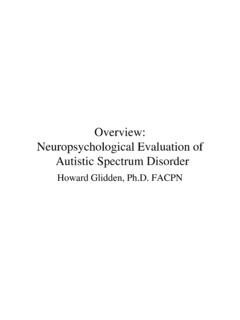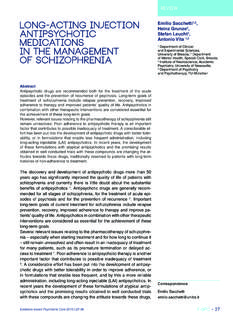Transcription of Reaching Out - Schizophrenia Society of Canada
1 ReachingOutReaching Out: Reaching Out:The Importance of early TreatmentReaching OutSchizophrenia Society of Canada 2003iReaching OutForewForewordordIntolerance and prejudice can only be changed by knowledge,understanding, and affects one in every 100 Canadians. The usualtime of onset for this neurobiological illness is between 15 and25 years of age. Thus, high school students are in the age groupthat is at risk. Unusual behaviours often attributed to adolescence may beindicative of the onset of mental illness. It is important to be aware of the early symptoms of schizophreniaand know when to seek professional help.
2 early intervention andtreatment greatly improve outcomes for the is essential for school personnel to provide prompt response tostudents who may be developing mental illness. These students areat risk for further deterioration, and could be at risk for seriousharm. While confidentiality is important, the teacher must act as ajudicious parent to help the student get the required medicalattention in a timely :Teachers should be prepared for potential may be required to provide additional follow up if concernsare raised. Counsellors should be knowledgeable about local protocolsand pathways to appropriate medical OutIf you would like to have a knowledgeable resource person from the Schizophrenia Society in your classroom for the videopresentation, contact your local Schizophrenia Society branch orchapter, (check local phone book), or the Schizophrenia Societyof Canada Schizophrenia Society of Canada is interested in hearing fromyou.
3 If you find this resource useful, or if you have suggestions orquestions, please let us know. Email messages can be sent or phone resource may be photocopied for educational Reaching OUT RESOURCE PACKAGE 20-minute video featuring a short drama and five people withschizophrenia talking about their experience with the illness Information for the teacher and students about Schizophrenia Lesson plans for two periods Resources and suggestions to extend the learningiiiReaching OutAcknoAcknowledgementswledgementsProdu ction of this document has been made possible by a financialcontribution from the Population Health Fund.
4 Health views expressed herein do not necessarily represent the officialpolicies of Health Canada . Health Canada , for publication and distribution support Diane Pollard, Coordinator, Special Programs Branch, BC Ministry of Education Clem Meunier, Mental Health and Youth Policy Section, BC Ministry for Children and Families British Columbia School Counsellors Association British Columbia Teachers Federation Administrative staff, teachers and students who participated in and provided feedback on this project:North Vancouver School DistrictBalmoral High Janine Duprey Carson Graham High Al Klatt, Mark LefroySutherland High Elizabeth Bell, Doug Green, Rae Kaleem, Jenny Minara Richmond School DistrictRichmond High Barbara Doerksen, Pat Kehoe, Darlene MacklamVancouver School DistrictJohn Oliver High John Chalk, Caroline HeshedahlJean Gelwicks, School Counsellor (retired) The initial Reaching Outpilot was developed, produced and editedby the BC Schizophrenia Society (BCSS) Education Committee.
5 Joan Nazif, Chair, Education CommitteeJane Duval, Policy Development and Communications, BCSSJ udith McPhie, Curriculum Development SpecialistLarry Richardson, Teacher, Vancouver OutTTabable of Contentsle of ContentsFOREWORD iACKNOWLEDGEMENTSiiiPART I:INTRODUCTIONL earning Outcomes1 Synopsis of the Video2 PART II:LESSON PLANSWhy teach Reaching Out?5 Notes to the Teacher7 Lesson Plan Outlines10 Suggested Preparation12 Lesson Plan: Period One13 True & False Questions 17 True & False Answers18 Schizophrenia Summary20 early Warning Signs21 Lesson Plan: Period Two23 Role Plays25 Major Understandings29 Major Understandings Answers45 PART III:OVERHEADS49 PART IV: RESOURCESE xtending the Learning63 Placement in School Curriculum65 Glossary of Terms66 Recommended Readings 69 Web Sites71 Article What is Psychosis?
6 73 Student Response Form81 Booklet:Basic Facts About Schizophrenia (Back sleeve of binder)PParart I Introductiont I Introduction LEARNING OUTCOMES SYNOPSIS OF THE VIDEOR eaching Out1 Reaching OutLearLearning Outcomesning OutcomesaStudents will understand why it is important for them to know this information now:i) The early symptoms of Schizophrenia commonly appearbetween the ages of 15 and 25 ) early intervention and treatment enhance the possibilityand opportunity for quality of Students will gain understanding about Schizophrenia andwill be aware of the early warning signs.
7 I) Schizophrenia is a brain ) Schizophrenia affects 1 in 100 people ) early warning signs may mimic drug ) Medication plays an important role in the treatment of ) Stigma and myths are barriers to ) Good resources are available to help find Students will understand their role if they suspect a friendor family member may have Schizophrenia :i) It is important to make contact with a responsible adult(counsellor, teacher, nurse, doctor, parent).ii) To support peers exhibiting symptoms requiresdeveloping the skills of: active listeningobservationempathy and compassiondStudents will understand that there is hope:i) Good treatment is available due to recent advances in brain research and new ) People with Schizophrenia can lead lives of purpose and I Introduction2 Reaching OutSynopsis of VideoSynopsis of VideoLength: 20 minutes DRAMA STORYLINELisa is a high school student who is worried about her friend,Todd.
8 When she shares her concerns with other friends, they saythat Todd is just a loser , and that he s probably doing drugs .Lisa goes to talk to her counsellor, Mr. Cousins. She expressesher worries about Todd his deteriorating appearance, his lackof interest in life, his puzzling hostility. She notes that over thelast year, he s really changed .After asking about the possibility of drug use, Mr. Cousinswonders if Todd might be becoming ill. He discusses with Lisawhat they learned about Schizophrenia and other serious brainillnesses. Mr. Cousins gives Lisa some references to look up onthe internet, and introduces her to Susan, a woman who hasschizophrenia.
9 Susan tells Lisa about her own experience withthe illness. She also stresses the fact that if Todd really is ill, it svery important that he get help as soon as possible .Lisa has known Todd s family for years, so she decides to go andtalk to his mother. As Todd s mother invites Lisa in, she tells Lisathat Todd s counsellor has already called with similar I Introduction3 Reaching OutDOCUMENTARYAt relevant points in the video, the scene shifts and we meet fivepeople who actually have Schizophrenia : Emily, Eric, Jamie, Paul,and Tim. They discuss their experiences with the illness. Theytalk about what it was like to be ill, how they finally got help, thesupport received from school, family and others, and the factthat good treatment is available, and it OF IMPORTANT IDEAS At the end of the video, the five Major Understandings arereviewed using excerpts from the video to illustrate each could be used to reinforce the information at the end ofthe video in Period One and/or to re-introduce the informationin Period Two.
10 Duration: 3 of VideoPART I Introduction4 Reaching OutNOTES: Reaching OutPParart II Lesson Planst II Lesson Plans WHY TEACH Reaching Out? NOTES TO THE TEACHER LESSON PLAN OUTLINES SUGGESTED PREPARATION LESSON PLAN: PERIOD ONE LESSON PLAN: PERIOD TWO5 Reaching OutWhWhy Ty Teach Reaching Out?each Reaching Out?People suffering from Schizophrenia or other serious mentalillnesses (bipolar disorder, clinical depression, etc.) have typicallybeen viewed as having an illness that precludes living a productivelife. The causes of mental illness have often been incorrectlyattributed to a poor home environment, which is a heartbreakingmessage for families witnessing the struggle of one of their familymembers.







